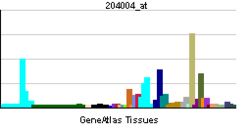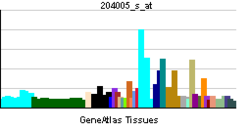- PAWR
-
For the airport in Alaska using the ICAO location indicator PAWR, see Whittier Airport.
PRKC, apoptosis, WT1, regulator, also known as PAWR or Prostate apoptosis response-4 (Par-4), is a human gene coding for a tumor-suppressor protein that induces apoptosis in cancer cells, but not in normal cells.
The tumor suppressor WT1 represses and activates transcription. The protein encoded by this gene is a WT1-interacting protein that itself functions as a transcriptional repressor. It contains a putative leucine zipper domain which interacts with the zinc finger DNA binding domain of WT1. This protein is specifically upregulated during apoptosis of prostate cells.[1] The active domain of the Par-4 protein has been found to confer cancer resistance in transgenic mice without compromising normal viability or aging, and may have therapeutic significance.[2]
Interactions
PAWR has been shown to interact with WT1,[3] THAP1,[4] SLC5A1,[5] DAPK3,[6] Apoptosis antagonizing transcription factor[7] and Protein kinase Mζ.[8]
References
- ^ "Entrez Gene: PAWR PRKC, apoptosis, WT1, regulator". http://www.ncbi.nlm.nih.gov/sites/entrez?Db=gene&Cmd=ShowDetailView&TermToSearch=5074.
- ^ Zhao Y, Burikhanov R, Qiu S, Lele SM, Jennings CD, Bondada S, Spear B, Rangnekar VM (2007). "Cancer resistance in transgenic mice expressing the SAC module of Par-4". Cancer Res. 67 (19): 9276–85. doi:10.1158/0008-5472.CAN-07-2124. PMID 17909035.
- ^ Johnstone, R W; See R H, Sells S F, Wang J, Muthukkumar S, Englert C, Haber D A, Licht J D, Sugrue S P, Roberts T, Rangnekar V M, Shi Y (Dec. 1996). "A novel repressor, par-4, modulates transcription and growth suppression functions of the Wilms' tumor suppressor WT1". Mol. Cell. Biol. (UNITED STATES) 16 (12): 6945–56. ISSN 0270-7306. PMC 231698. PMID 8943350. http://www.pubmedcentral.nih.gov/articlerender.fcgi?tool=pmcentrez&artid=231698.
- ^ Roussigne, Myriam; Cayrol Corinne, Clouaire Thomas, Amalric François, Girard Jean-Philippe (Apr. 2003). "THAP1 is a nuclear proapoptotic factor that links prostate-apoptosis-response-4 (Par-4) to PML nuclear bodies". Oncogene (England) 22 (16): 2432–42. doi:10.1038/sj.onc.1206271. ISSN 0950-9232. PMID 12717420.
- ^ Xie, Jun; Guo Qing (Jul. 2004). "Par-4 inhibits choline uptake by interacting with CHT1 and reducing its incorporation on the plasma membrane". J. Biol. Chem. (United States) 279 (27): 28266–75. doi:10.1074/jbc.M401495200. ISSN 0021-9258. PMID 15090548.
- ^ Kawai, Taro; Akira Shizuo, Reed John C (Sep. 2003). "ZIP kinase triggers apoptosis from nuclear PML oncogenic domains". Mol. Cell. Biol. (United States) 23 (17): 6174–86. doi:10.1128/MCB.23.17.6174-6186.2003. ISSN 0270-7306. PMC 180930. PMID 12917339. http://www.pubmedcentral.nih.gov/articlerender.fcgi?tool=pmcentrez&artid=180930.
- ^ Guo, Qing; Xie Jun (Feb. 2004). "AATF inhibits aberrant production of amyloid beta peptide 1-42 by interacting directly with Par-4". J. Biol. Chem. (United States) 279 (6): 4596–603. doi:10.1074/jbc.M309811200. ISSN 0021-9258. PMID 14627703.
- ^ Díaz-Meco, M T; Municio M M, Frutos S, Sanchez P, Lozano J, Sanz L, Moscat J (Sep. 1996). "The product of par-4, a gene induced during apoptosis, interacts selectively with the atypical isoforms of protein kinase C". Cell (UNITED STATES) 86 (5): 777–86. doi:10.1016/S0092-8674(00)80152-X. ISSN 0092-8674. PMID 8797824.
Further reading
- El-Guendy N, Rangnekar VM (2003). "Apoptosis by Par-4 in cancer and neurodegenerative diseases.". Exp. Cell Res. 283 (1): 51–66. doi:10.1016/S0014-4827(02)00016-2. PMID 12565819.
- Gurumurthy S, Rangnekar VM (2004). "Par-4 inducible apoptosis in prostate cancer cells.". J. Cell. Biochem. 91 (3): 504–12. doi:10.1002/jcb.20000. PMID 14755681.
- Ranganathan P, Rangnekar VM (2006). "Regulation of cancer cell survival by Par-4.". Ann. N. Y. Acad. Sci. 1059: 76–85. doi:10.1196/annals.1339.046. PMID 16382046.
- Díaz-Meco MT, Municio MM, Frutos S, et al. (1996). "The product of par-4, a gene induced during apoptosis, interacts selectively with the atypical isoforms of protein kinase C.". Cell 86 (5): 777–86. doi:10.1016/S0092-8674(00)80152-X. PMID 8797824.
- Bonaldo MF, Lennon G, Soares MB (1997). "Normalization and subtraction: two approaches to facilitate gene discovery.". Genome Res. 6 (9): 791–806. doi:10.1101/gr.6.9.791. PMID 8889548.
- Johnstone RW, See RH, Sells SF, et al. (1997). "A novel repressor, par-4, modulates transcription and growth suppression functions of the Wilms' tumor suppressor WT1.". Mol. Cell. Biol. 16 (12): 6945–56. PMC 231698. PMID 8943350. http://www.pubmedcentral.nih.gov/articlerender.fcgi?tool=pmcentrez&artid=231698.
- Guo Q, Fu W, Xie J, et al. (1998). "Par-4 is a mediator of neuronal degeneration associated with the pathogenesis of Alzheimer disease.". Nat. Med. 4 (8): 957–62. doi:10.1038/nm0898-957. PMID 9701251.
- Johnstone RW, Tommerup N, Hansen C, et al. (1998). "Mapping of the human PAWR (par-4) gene to chromosome 12q21.". Genomics 53 (2): 241–3. doi:10.1006/geno.1998.5494. PMID 9790775.
- Kruman II, Nath A, Maragos WF, et al. (1999). "Evidence that Par-4 participates in the pathogenesis of HIV encephalitis.". Am. J. Pathol. 155 (1): 39–46. PMC 1866661. PMID 10393834. http://www.pubmedcentral.nih.gov/articlerender.fcgi?tool=pmcentrez&artid=1866661.
- Guo Q, Xie J, Chang X, Du H (2001). "Prostate apoptosis response-4 enhances secretion of amyloid beta peptide 1-42 in human neuroblastoma IMR-32 cells by a caspase-dependent pathway.". J. Biol. Chem. 276 (19): 16040–4. doi:10.1074/jbc.M010996200. PMID 11278808.
- Chakraborty M, Qiu SG, Vasudevan KM, Rangnekar VM (2001). "Par-4 drives trafficking and activation of Fas and Fasl to induce prostate cancer cell apoptosis and tumor regression.". Cancer Res. 61 (19): 7255–63. PMID 11585763.
- Chang S, Kim JH, Shin J (2002). "p62 forms a ternary complex with PKCzeta and PAR-4 and antagonizes PAR-4-induced PKCzeta inhibition.". FEBS Lett. 510 (1-2): 57–61. doi:10.1016/S0014-5793(01)03224-0. PMID 11755531.
- Ohki R, Yamamoto K, Mano H, et al. (2002). "Identification of mechanically induced genes in human monocytic cells by DNA microarrays.". J. Hypertens. 20 (4): 685–91. doi:10.1097/00004872-200204000-00026. PMID 11910304.
- Hsu SC, Kirschenbaum F, Miller J, et al. (2003). "Structural and functional characterization of the upstream regulatory region of the human gene encoding prostate apoptosis response factor-4.". Gene 295 (1): 109–16. doi:10.1016/S0378-1119(02)00826-0. PMID 12242017.
- Strausberg RL, Feingold EA, Grouse LH, et al. (2003). "Generation and initial analysis of more than 15,000 full-length human and mouse cDNA sequences.". Proc. Natl. Acad. Sci. U.S.A. 99 (26): 16899–903. doi:10.1073/pnas.242603899. PMC 139241. PMID 12477932. http://www.pubmedcentral.nih.gov/articlerender.fcgi?tool=pmcentrez&artid=139241.
- Cheema SK, Mishra SK, Rangnekar VM, et al. (2003). "Par-4 transcriptionally regulates Bcl-2 through a WT1-binding site on the bcl-2 promoter.". J. Biol. Chem. 278 (22): 19995–20005. doi:10.1074/jbc.M205865200. PMID 12644474.
- Boehrer S, Chow KU, Ruthardt M, et al. (2003). "Expression and function of prostate-apoptosis-response-gene-4 in lymphatic cells.". Leuk. Lymphoma 43 (9): 1737–41. doi:10.1080/1042819021000006510. PMID 12685825.
- Roussigne M, Cayrol C, Clouaire T, et al. (2003). "THAP1 is a nuclear proapoptotic factor that links prostate-apoptosis-response-4 (Par-4) to PML nuclear bodies.". Oncogene 22 (16): 2432–42. doi:10.1038/sj.onc.1206271. PMID 12717420.
- El-Guendy N, Zhao Y, Gurumurthy S, et al. (2003). "Identification of a unique core domain of par-4 sufficient for selective apoptosis induction in cancer cells.". Mol. Cell. Biol. 23 (16): 5516–25. doi:10.1128/MCB.23.16.5516-5525.2003. PMC 166354. PMID 12897127. http://www.pubmedcentral.nih.gov/articlerender.fcgi?tool=pmcentrez&artid=166354.
Categories:- Human proteins
- Chromosome 12 gene stubs
Wikimedia Foundation. 2010.



